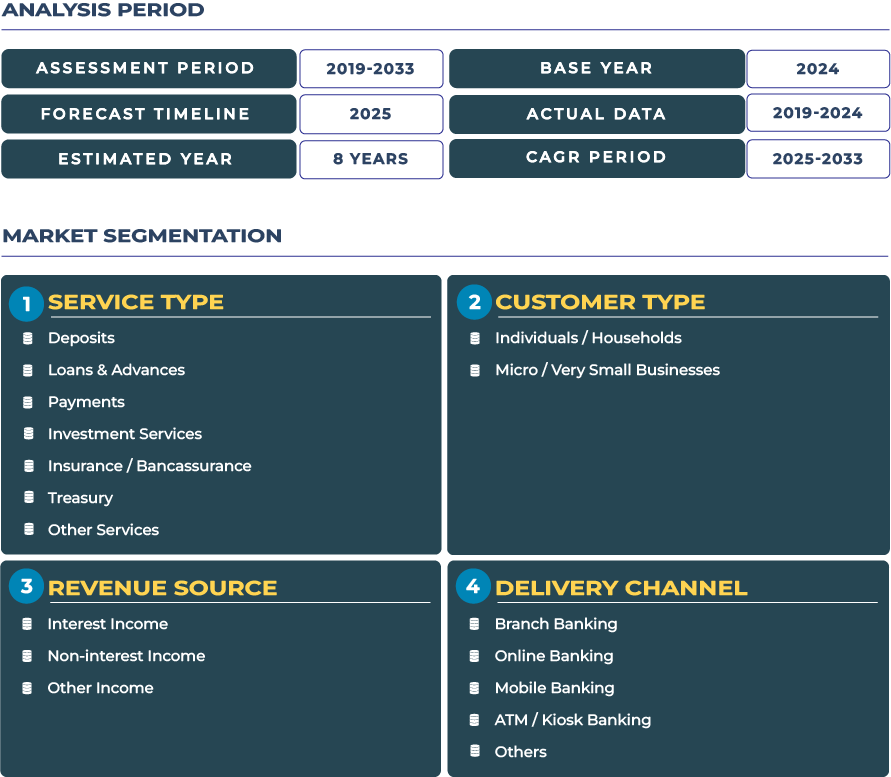Digital-First Banking Post-Brexit: Transforming the UK Retail Banking Frontier
The United Kingdom finds itself in a pivotal moment for retail banking, leveraging fintech innovation, open banking mandates, and post-Brexit regulatory recalibration to drive a digital-first paradigm. In the wake of regulatory divergence and evolving competitive dynamics, UK banks are accelerating partnerships with challenger fintechs, embedding contactless payments, and streamlining mobile banking experiences to defend relevance.
Note:* The market size refers to the total revenue generated by banks through interest income, non-interest income, and other ancillary sources.
Market Outlook: Strategic Trajectories in UK Retail Banking’s Next Chapter
From 2025 to 2033, projected growth to USD 149.8 billion at a 1.9% CAGR signals a steady but challenging environment. Traditional banking services-current and savings accounts, mortgage lending, consumer credit-will continue to anchor core volumes, but incremental growth must stem from digital adoption, fee-based products, and cross-sell synergies. The climbing adoption of digital payments, embedded finance, and banking as a service models will progressively shift revenue contribution from interest income to non-interest streams. The UK government’s Financial Services Growth and Competitiveness Strategy aims to sharpen regulatory frameworks, streamline approvals, and foster innovation-measures intended to bolster growth potential and competitiveness. During this period, macro pressures-such as inflation, monetary policy tightening, economic cycles, and global volatility-will continue to weigh on margins and credit demand. Banks that can marry disciplined cost control with digital investments, risk resilience, and modular platforms will emerge as winners in the evolving UK retail banking landscape.
Drivers & Restraints: Deep Currents Shaping UK Retail Banking Evolution
Growth Levers: Digital Penetration, Fintech Partnerships & BaaS Adoption
A key driver is the UK high smartphone penetration and entrenched consumer habit of online banking, which reduce friction in rolling out digital services. Banks are increasingly collaborating with fintechs to integrate modules-lending, analytics, wallets-leading to modular architecture shifts and faster product cycles. The Banking-as-a-Service (BaaS) market in the UK is also scaling, expected to grow strongly over the coming decade, enabling non-bank platforms to embed banking capabilities and expanding the addressable ecosystem. These trends intensify network effects and enable incumbents to monetize platform participation beyond traditional banking roles.
Constraining Factors: Brexit Uncertainty, Cyber Risk & Regulatory Overhang
Post-Brexit regulatory recalibration introduces uncertainty in cross-border licensing, equivalence regimes, and oversight of fintech-bank interplay. The UK retains regulatory autonomy, but evolving divergence from EU rules may complicate operations for UK banks serving EU clients. Cybersecurity and privacy risks remain acute-banks must sustain heavy investments in identity protection, fraud detection, and resilience. Moreover, the UK regulatory shifts raise compliance burdens. The pace of branch closures also poses customer access challenges, particularly for elder and rural segments, raising reputational, policy, and inclusion pressures. The confluence of these constraints demands that UK retail banks manage transformation within an environment of cost discipline, regulatory prudence, and consumer trust management.
Trends & Opportunities: What’s Defining the UK Retail Banking Frontier?
Trend: Rise of Digital-Only Banks & Uptake of Contactless Payments
Digital-only banking models (e.g. Monzo, Revolut, Starling) continue to draw younger demographics with slick UX, low fees, and seamless features. These challengers fuel competitive pressure across product design, speed, and cost structure. Concurrently, contactless payments and mobile wallets are becoming default modes of retail transaction: more than half of UK adults now use digital payments routinely. The shift to digital sales channels and e-commerce accelerates integration of banking into everyday life, compressing product discovery and adoption cycles. The confluence of digital banking adoption and seamless payments is driving blurring lines between banking and commerce alliances.
Opportunity: Fintech Alliances & AI-Driven Credit Scoring Engines
The most compelling growth opportunity lies in deep partnerships with fintechs-enabling banks to extend reach into under-penetrated segments with modular, niche products. These alliances can help scale micro-loans, embedded payments, wealth tools, and insurance bundling. Another frontier is AI-driven credit scoring: the Bank of England and FCA report that 75% of firms already use AI or plan to within three years. Deploying predictive underwriting, adaptive models, and alternative data can reduce default risk and speed lending decisions. As digital adoption deepens, banks can leverage real-time customer data to dynamically price and cross-sell services, improving wallet share and yield per user.
Competitive Landscape: Strategic Moves Among UK Retail Banking Incumbents
The UK retail banking sector remains concentrated, dominated by players such as HSBC UK, Lloyds Banking Group, Barclays, NatWest, and Santander UK. Many are accelerating digital transformation and branch rationalization. For instance, Lloyds Banking Group has announced closure of 136 branches between May 2025 and March 2026, reallocating capital toward digital services. Branch footprint contraction is symptomatic of a broader shift: high fixed cost branches are giving way to digital channels, and hybrid advisory hubs are emerging. Incumbents are also integrating AI analytics, real-time risk scoring, fraud orchestration, and API-driven platforms. Some have acquired niche digital banks or fintech startups to bolster talent and capabilities. The push is toward modular architecture, seamless cross-product journeys, and secure digital trust. Across this competitive environment, survival and growth hinge on speed of innovation, data use, and operational resilience-not just scale alone.







